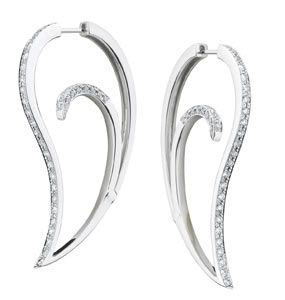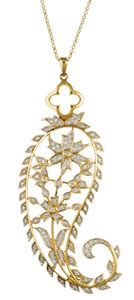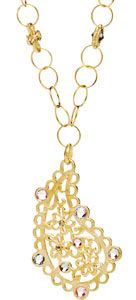Passion For Paisley

The swirling teardrop shape first associated with shawls, quilts, and rugs has found its way into the imaginations and collections of leading luxury jewelers.
The paisley motif, which first originated in Persia in the 1500’s, was used in textile design to decorate royal interiors and court garments. The pattern was soon adopted in India with delicate and intricate floral and foliage motifs.
For the new season, jewelry designers are reinterpreting paisleys found in embroidery fabrics and lace motifs. They are spinning these looks, which range from richly flowery and colorful to embellished yet subtle, into gold with diamond and gemstone accents. Designers also borrow their influences from the ornamental saris and silks of India and the cashmere shawls from Kashmir.




Best of the Emmys Runways, red carpets.
Television's biggest celebrities at the Emmy Awards Sunday overwhelmingly felt nostalgic for old Hollywood with red lips and white dresses, updos, and glam jewels.
After teasing us last year with a return to necklaces, bare necks are back. Earrings, bracelets, and rings, however, are bold, elegant, and, happily, interesting in design.
Some of the top trends at Emmys were:
Deco Inspiration. Clean geometric designs, and deco-inspired swingy drop earrings went well with hints of flapper in fringe and dropped waists.
Yellow gold. Yellow was a surprising contrast to the traditional white-on-white looks of past seasons.
Black Jewels. Blackened metal offered an antique look when set with diamonds. Others chose dark metal (or black pearls and gemstones) for a sharp and modern contrast to white gowns.
Bold Drops. Drop-earring silhouettes are still the favorite, but linear drops have been replaced by bolder looks. Forward hoops, oversize geometric shapes, and multiple drop designs were most popular.



"Home Parties offer a comfortable environment for jewellery shopping"

Those involved in the industry say the development of such parties are the root for the increased trend toward female self-purchasers and women's desire to socialize despite hectic schedules. Parties are a nice way to combine shopping with a social life. In parties people don't feel obligated to buy, however they usually do.Women can try on the jewelry with their friends, and it gives them a great time out.
If you’re thinking of getting in on the party, here are a few tips to help get you started:
* Market to clients you already know: Suggest a jewelry home-party to a
new bride looking for something to share with her bridesmaids, or to a
female client you know has an active social circle.
* Keep inventory big, parties small: Part of the appeal of home-parties
is the ability for clients to try on jewelry in the comfort of their home,
minus feeling the pressure to buy. Keep parties small enough that everyone
can handle the jewelry without creating security issues.
* Build on your brand: Use jewelry parties as an opportunity to promote
your brand. Bring stylish displays and boxes for purchases, and make sure
everyone goes home with a catalog. 
* Give it time: Don’t be discouraged by a slow start. As with any new
business venture, it may take time for the idea to catch on with consumers. .
.
Hong Kong SEPTEMBER Gem And Jewellery Show
One of the world's top three jewellery events
The Fair is the single largest display of the world's jewellery and jewellery products in Asia, showcasing a wide range of products from fine finished jewellery, polished diamonds and gemstones, to all varieties of pearls, jewellery timepieces, packaging, displays, as well as jewellery-making equipment, tools and machinery.
One Fair‧Two Venues‧One Great City
Space limitations at the Hong Kong Convention & Exhibition Centre are the reason many potential exhibitors are on the waiting list to participate in the Fair, while many existing exhibitors who would like to expand their booths are unable to do so at present. The 2007 edition of September Hong Kong Jewellery & Watch Fair will be held at both the Hong Kong Convention &
Exhibition Centre and AsiaWorld-Expo as follows:
23 - 28 September 2007 at AsiaWorld-Expo
25 - 29 September 2007 at Hong Kong Convention & Exhibition Centre
The Fair is:
the biggest jewellery fair in Asia
the biggest pearl fair in the world
the second biggest diamond and gemstone fair in the world
Over 2,400 exhibitors from 47 countries/regions
Over 40,000 visitors from 140 countries/regions
Over 80,000 square metres of exhibition space
Gemstone Setting Types : Closed and Open Settings
There are two basic types of gemstone settings: open settings and closed settings. Open settings are any type of setting that allows light to enter through the bottom of a faceted or transparent cabochon gemstone.
In a "closed setting" light can only enter the stone from the top. This type of setting is appropriate for opaque cabochon-cut stones and highly refractive faceted stones where light can enter through the crown and table of the stone and be reflected back to the observer from within.
Open Gem Setting Types
Prong Settings
Within the category of "open settings" there are several variations. The most common variety for faceted gemstones is a prong setting (below, left), with either 3 or 4 prongs that hold the stone in place. This type of setting exposes the maximum amount of light to the sides and bottom.

Carré setting
A Carré setting is where the stone is seated directly over a light well (above, right), and the stone is set by raising (hammering) four "spurs" with a "graver" tool.
Tension Settings
A "tension setting" uses the metal's natural tendency to "spring" back to its original position to hold the stone in place. The metal is spread apart, and the girdle of the stone is seated into small grooves in the inside surface of the metal. This type of setting requires special alloys of metal that are strong enough to create and withstand the necessary pressure to hold the stone firmly. Tension settings are only appropriate for very hard stones (Hardness of 9 to 10: diamond, ruby, sapphire, cz or moissanite).

Frustum Settings
A Frustum, or "Hollow Cone" setting is a conical or tapered setting constructed from sheet metal. The stone's pavilion rests against the inside of the cone and the outer edge of the cone's lip is bet over the girdle to secure the stone. A frustum setting can be open or closed.
Closed Gem Setting Types
Variations of the closed setting are the "bezel” setting, channel setting, cluster setting, Kundan setting, frustum setting, Pavé, and the seamless tube setting.
Bezel Settings
The oldest and most basic gemstone setting is the "Bezel". Used primarily to set cabochons, a vertical strip of metal is formed to encircle the stone, then soldered to a metal base. The stone is secured by pushing and bending the bezel towards the stone using a burnishing tool.

Channel settings
Channel settings are primarily used to set faceted gemstones that are straight-sided, or quadrilateral in shape (baguette or princess cut). The stones are aligned in a channel, sitting girdle-to-girdle. step-cut stones can rest on a track giving a "keystone" effect. Matching stones that are cut to a uniform size for use in channel settings are called "calibré-cut," as in "Eternity Rings."

Pavé Settings
A Pavé Setting is a tight grouping of identically sized stones laid across a flat, or convex surface, from the French word for "paved." The stones are held in place using three to six raised beads per stone.











 .
.





